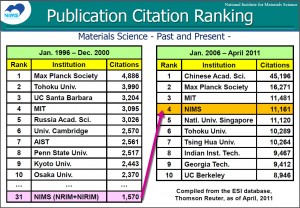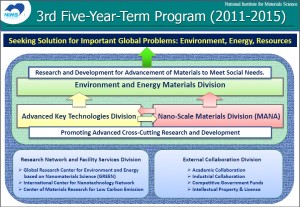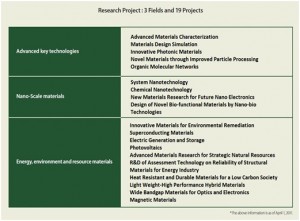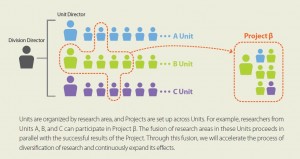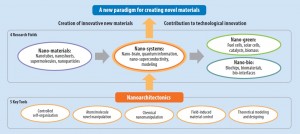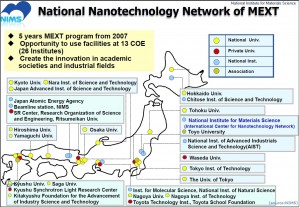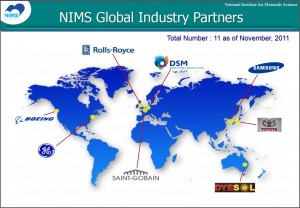Kikuo Hayakawa, NOST Tokyo
Originally published on the site of NL Agency.
The National Institute for Materials Science (NIMS) in Japan is one of the successful research institutes in the field of material science. NIMS ranked 4th in the world for the number of citations in the materials science field over the last five years. NIMS has been selected as a core research center in the field of nanotechnology and materials science by the Japanese government in 2007. The International Center for Materials Nanoarchitectonics (MANA), established within NIMS, plays a major role in the field of nanotechnology & materials science in Japan. MANA has seventeen research units, for instance, of which the Nano-system field is creating next-generation electric devices using nanoarchitechtonics, such as atomic switches, atom transistors, graphene devices, and devices with a synapse function for realizing a ‘brain-type’ computer. NIMS is one of the core research institutes to promote an open innovation cluster, TIA-nano (Tsukuba Innovation Arena), aiming at the promotion of value creations in the industry. The total operational budget of NIMS is 209 million euro, funded by the government (ninety percent) and the industry (ten percent). NIMS has promoted the international collaborations with foreign universities and companies. There are more than 270 foreign researchers in NIMS, which account for nineteen percent of the total staff. NIMS has signed thirty-seven agreements with foreign universities in fifteen countries and regions, and eleven agreements with multinational companies, including Nijmegen High Field Magnetic Laboratory and DSM in the Netherlands. NIMS is open to explore mutually fruitful collaborations with research institutes in the Netherlands.
Abstract of NIMS
The National Institute for Materials Science (NIMS) has been established in April 2001 as a merge of the former governmental research institutes National Research Institute for Metals and National Institute for Research in Inorganic Materials. NIMS is Japan’s sole Independent Administrative Institution (IAI) specializing in materials science. NIMS has four missions: 1) Basic scientific and engineering research; 2) Utilization research results for society; 3) Shared use of advanced facilities and equipment; and 4) Training of scientists and engineers (1). NIMS has conducted research that is at the leading edge of the world’s materials science and has covered materials encompassing not only metals or ceramics but also organic materials and biomaterials. To build a sustainable society, NIMS has conducted research in order to produce new materials that use nanotechnology – this being a technology enabling research concerning atoms/molecules in the materials science field. NIMS also does research that realizes higher functions for materials (2). NIMS research has been highly recognized for recent years. According to the ESI database (Thomson Reuter), NIMS ranked fourth in the world for the number of citations in the materials science field over the last five years (January 2006 – April 2011) (figure 1). The total operational budget of NIMS is 209 million euro (22 billion yen), of which the governmental subsidy and fund account for ninety percent and the industry fund (companies and licenses etc) accounts for ten percent. At present, prof. Sukekatsu Ushioda is president of NIMS, who leads a total of 1,460 staff including 1,109 researchers in NIMS (as of June 2011).
Figure 1. Publication Citation Ranking – NIMS (source: NIMS)
Third Five-Year Program started in 2011
NIMS started the Third Five-Year Program in 2011 and is committed to achieve an even higher level in the various technologies which it has developed to date and in the search for materials at nano-scale. NIMS will assign particular priority on research and development for the advancement of materials to meet social needs, aiming at solving important global problems, exemplified by environment, energy, and resources-related problems (figure 2). Under the Third Mid-Term Program, the former research areas and centers were reorganized into a system of three research divisions and one center (figure 3). In each of these research divisions ‘units’ are formed, bringing together researchers with a high degree of specialization in more closely-defined areas. The three divisions are the ‘Environment and Energy Materials Division’, ‘Nano-scale Materials Division/MANA’, and ‘Advanced Key Technologies Division’. The center is the ‘Research Center for Strategic Materials’. Besides, the former project research, which comprised thirty projects in six fields, were integrated into nineteen projects in three fields under the Third Five-Year Program (3). The largest number of projects is in the field of energy, environment and resource materials, where ten projects are underway (figure 4). The nineteen projects are set up across the units in the research divisions. Researchers of different units are participating in each of the projects. The fusion of research areas in these units proceeds in parallel with the successful results of the project (figure 5).
Figure 2. 3rd Five-Year-Term Program (2011-2015) (source: NIMS)
Figure 3. Research Organization: 3 Research Divisions and 1 Center (source: NIMS)
Figure 4. Research Project: 3 Fields and 19 Projects (source: NIMS)
Figure 5. Relation between Research Division/Unit and Project (source: NIMS)
Nanotechnology Research Centers in NIMS
The International Center for Materials Nanoarchitectonics, the Global Research Center for Environment and Energy based on Nanomaterials Science, the Center of Materials Research for Low Carbon Emission and the Nanotechnology Network Japan have been established in NIMS to tackle problem-solving type research projects funded by the Japanese government and the other institutions, which are described below.
1. International Center for Materials Nanoarchitectonics (MANA)
MANA is one of the six research centers conducting the world’s biggest research programs (known as the WPI Program), under the auspices of the Ministry of Education, Culture, Sports, Science and Technology (MEXT) in Japan (4). The University of Tokyo (astrophysics), Kyoto University (stem cells), Tohoku University (materials science), Osaka University (immunology) and NIMS (nanotechnology & material science) have become the sole independent administrative institution funded by the WPI Program since 2007, followed by Kyushu University (hydrogen energy) since 2010. Under the Third Five-Year Program, MANA becomes the Nano-scale Materials division, one of the new research divisions in NIMS. As mentioned, MANA holds seventeen research units, of which the Nano-system field (Unit Director: Dr. Masakazu Aono, Director-General, MANA), for instance, focuses on creating the next generation electric devices using nanoarchitechtonics. Atomic switches, atom transistors, graphene devices, single-atomic-layer ‘monolayer’ devices, superconducting nanodevices, molecular devices and devices with a synapse function for realizing a ‘brain-type’ computer etc (5). The Nano-system field group aims to contribute to a new paradigm for creating novel materials (figure 6).
MANA has promoted internationalization by constructing an international, interdisciplinary research environment, training young scientists and research leaders, introducing bilingual administrative procedures, etc. MANA has 200 researchers in total, of which 112 are foreigners.
Figure 6. MANA Nano-system by Nanoarchitechtonics (source: NIMS)
2. Global Research Center for Environment and Energy based on Nanomaterials Science (GREEN)
In 2009 NIMS established the ‘Innovative Center of Nanomaterials Science for Environment and Energy’ to carry out a national project: ‘Development of environmental technologies utilizing nanotechnology’, sponsored by MEXT. NIMS works on engineering problems directly applicable to real-world problems. At the same time NIMS explores theoretical and computational approaches to materials science problems that are relevant in energy providing processes starting from solar energy conversion (6).
3. Center of Materials Research for Low Carbon Emission
The creation of a low-carbon society is a challenge which the whole world should work on immediately. ‘Green Nanotechnology’ (nanotechnology for environment- and energy-technology) will play a very important role to create the low-carbon society.
In order to realize this, it is essential to develop innovative materials that can efficiently achieve the goals for ‘renewable energy’ and ‘conservation of energy’. The Low-Carbon Research Network Japan (LCNet) has been established in NIMS, funded by MEXT since 2009. To support LCNet, the Center of Materials Research for Low Carbon Emission has been launched in NIMS in April 2012, which is the hub center for material design and fabrication. The facilities are open to all researchers inside and outside LCNet (7).
4. Nanotechnology Network Japan (Nanotech Japan)
Nanotechnology Network Japan (Nanotech Japan), funded by MEXT, consists of one main body of the ‘Open Advanced Facilities Initiative for Innovation’, since nanotechnology itself has been playing a fundamental role in various fields of science and technology. The techniques, such as ‘Nanofabrication’, ‘Nano-characterization and Analysis’, ‘Molecular Synthesis and Analysis’ and ‘Extreme Conditions’ are the most exciting fields in advanced science and technology including industrial ones. It is strongly anticipated that the integration of these technologies in the field of IT, environment, energy and life science will create large and unexpected break-throughs in future life and society. For five years starting from 2007, academic, business, and governmental nanotechnology researchers will have the opportunity to use facilities and equipment at thirteen network centers (26 institutes) with cutting edge nanotechnology. The aim of this program is to generate research results that would lead to innovations, enabled by high-level technical support in nanotechnology to various requests from the research community (8) (figure 7).
Figure 7. Nanotechnology Network Japan (source: NIMS)
Collaborations with foreign research institutes and companies
NIMS has also constructed an international network with research centers in other countries under international cooperation agreements, such as the World Materials Research Institute Forum (WMRIF) (2). Prof. Kishi (President, NIMS at the time) was designated as the first president of the organization in 2007. Under his initiative, seven working groups were organized and it was decided that these groups should play the main role in looking for solutions to challenges in the study of materials science and to further promote collaboration. Currently, forty-seven institutes for material science research from twenty-one countries are the participants of WMRIF. WMIRIF is growing into a potent organization with an influence in developing international strategies in the field of material study (9).
NIMS has signed thirty-seven agreements with foreign universities in fifteen countries and regions. NIMS has advanced facilities and equipment such as 37 T magnets, 930 MHz NMR, HVTEM, and SR beam line etc. Dutch Nijmegen High Field Magnetic Laboratory (HRML) and NIMS have signed an agreement on the development of magnet in 2003. NIMS provides an internship program and some graduate school programs for foreign researchers to help them do research at NIMS. The NIMS International Center for Young Scientists (ICYS) program provides a ‘Melting Pot’ environment mixing different research fields and cultures (10). MESA+/Twente University is recently in good contact with NIMS. Two young researchers from MESA+ have performed research at NIMS using the internship program.
For NIMS, the collaboration with companies is of the utmost importance. The Third Five-Year Program prioritizes three elements in collaboration with private companies. NIMS provides companies with 1) extremely high potential for basic research in materials science with the large number of scientific papers published by NIMS researchers, 2) advanced generic/infrastructural facilities and equipment which are difficult for individual companies to own and maintain, 3) use of intellectual property produced by this kind of joint research with companies. NIMS is open to mutually fruitful collaborations with companies in the Netherlands.
Tsukuba Innovation Arena (TIA-nano)
Since 2009, an open innovation cluster called the Tsukuba Innovation Arena (TIA-nano) has been launched in the Tsukuba area, where a wider range of research infrastructure is located, to further expand the possible collaborative research. TIA-nano was established under the leadership of NIMS, the National Institute of Advanced Industrial Science and Technology (AIST), and the University of Tsukuba, in cooperation with the industry, aiming at the promotion of value creations in the industry. The Tsukuba area has been developed as a research park since the 1970s, involved by core research institutes such as the AIST, NIMS and the University of Tsukuba, and has accumulated more than 300 public and private institutions and over 12,000 researchers (11). TIA-nano provides to six core domains on research and three core infrastructures shared (figure 8).
Figure 8. Core Competencies of TIA Nano (source: TIA nano)
Global Industry Partners with NIMS:
NIMS has signed eleven agreements with multinational companies, including Rolls Royce, Saint-Gobain, Dutch DSM and Toyota (figure 8). The Rolls Royce Centre of Excellence for Aerospace Materials has been established in NIMS in 2006 to do research on ultra-high temperature alloy for aircraft engines for five years. NIMS-Toyota Materials Center of Excellence for Sustainable Mobility has been established in 2008. Dutch DSM and NIMS has signed the agreement on collaborative research in biomedical-related materials science in July 2010. NIMS-Saint-Gobain Center of Excellence for Advanced Materials has been established in September 2010. NIMS is open to explore mutually fruitful collaborations with foreign countries such as the Netherlands.
Figure 9. NIMS Global Industry Partners (source: NIMS)
Currency:
1 euro = 105 yen (as of April 17, 2012)
Sources:
1) NIMS Overview, Presentation for Universities and Institutes in the Netherlands, April 2012 (NIMS)
2) NIMS – www.nims.go.jp
3) NIMS NOW International, No.3 April 2011 (NIMS)
4) MANA – International Center for Material Nanoarchitectonics – www.nims.go.jp/mana
5) NIMS NOW International, No.1, January-February 2012 (NIMS)
6) GREEN – www.nims.go.jp/GREEN/en
7) Center of Materials Research for Low Carbon Emission – http://www.nims.go.jp/low_carbon/en
8) Nanotechnology Network Japan – https://nanonet.nims.go.jp/english/
9) WMRIF – http://www.wmrif.info/
10) NIMS International Center for Young Scientists – http://www.nims.go.jp/icys/
11) TIA-nano – http://tia-nano.jp/en

